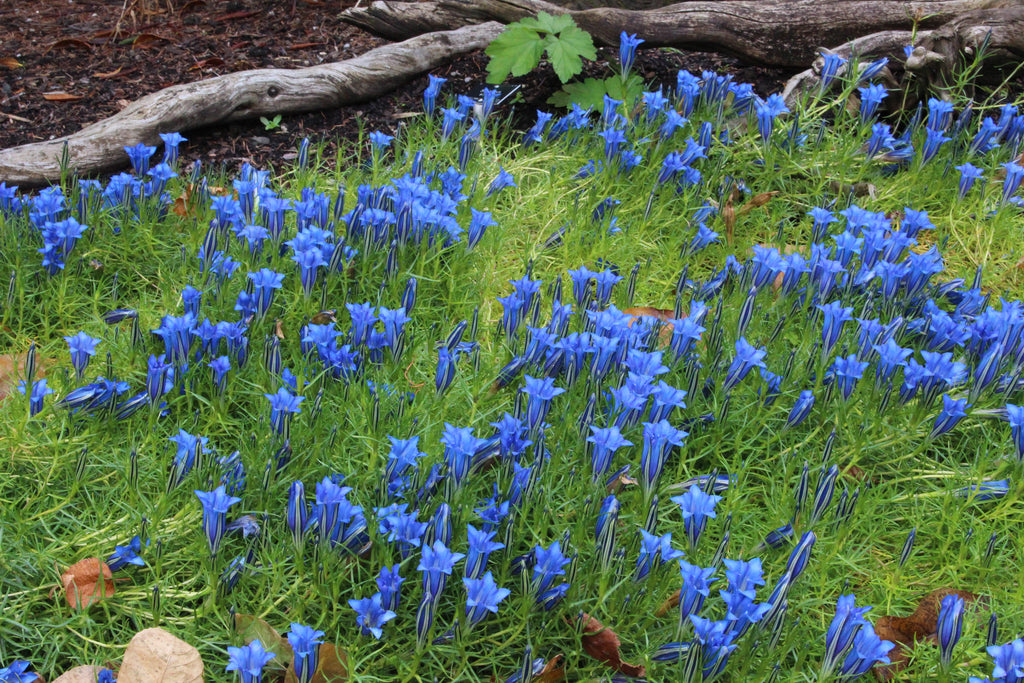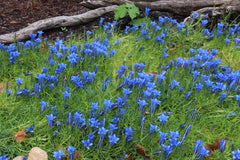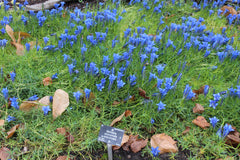


About this cultivar:
Gentiana sino-ornata, commonly called, showy Chinese gentian, is a species of flowering plant in the family Gentianaceae, native to western China and Tibet. Interestingly the latin species name also translate as 'showy Chinese'. It is a perennial with trailing stems to 20cm in length, bearing narrow leaves and solitary, terminal, rich blue, funnel-shaped flowers up to 6cm in length, with white stripes within.
The Scottish botanist George Forrest (1873-1932) first found Gentiana sino-ornata in NW Yunnan in 1904 and in the Lichiang mountain range in 1910. He was honoured with the Royal Horticultural Society's Victoria Medal of Honour in 1921, and the Veitch Memorial Medal in 1927, and was elected a Fellow of the Linnean Society in 1924.
Seeds sent to Edinburgh and Ness Botanic Gardens first flowered in 1912.
This plant is an autumn classic- reliable and easy to grow in a border, wall or container, and a winner of the Royal Horticultural Society Award of Garden Merit (RHS AGM) it, however, does not like alkaline soil!
- Position: Full sun, partial shade
- Soil: Almost any soil, grows well in Ballyrobert (but doesn't like alkaline soils or water)
- Flowers: July, August, September
- Other features: Grows well in Ballyrobert
- Hardiness: H5 - Hardy in most places throughout the UK even in severe winters (-15 to -10°C), Fully hardy - grows well in Ballyrobert!
- Habit: Trailing
- Foliage: Deciduous
- Height: 5 - 15 cm (0.15 - 0.5 ft)
- Spread: 10 - 45 cm (0.3 - 1.5 ft)
- Time to full growth: 2 to 5 years
- Plant type: Herbaceous Perennial
- Colour: Green, blue
- Goes well with: Carex and Iris or think about other small pants like Primula auricula, Pulsatilla vernalis and Saxifraga
About this genus:
Gentiana (jen-she-an-a) is a genus of flowering plants belonging to the gentian family (Gentianaceae),. With about 400 species it is considered a large genus. They are notable for their medicinal properties and mostly large, trumpet-shaped flowers, which are often of an intense blue, but can be white. The genus name is a tribute to Gentius, an Illyrian king who may have been the discoverer of tonic properties in gentians.
Gentians prefer a sunny to part-shade site and are known for loving moisture, but will not tolerate being waterlogged. Often thougth of a wild-flower (Gentiana verna can still be found growing wild in western Ireland) in the right spot in a garden, Gentians will provide you with beautiful blue, butterfly-attracting flowers in late summer or autumn.
You can plant them in a wild fashion, but don't feel constrained. Try combining with other moisture-loving plants such as Carex and Iris or think about other small pants like Primula auricula, Pulsatilla vernalis and Saxifraga. Gentians are perfect for rock gardens, alpine beds, containers or the front of a perennial border.

